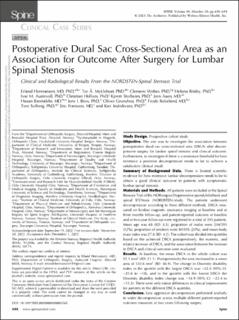| dc.contributor.author | Hermansen, Erland | |
| dc.contributor.author | Myklebust, Tor Åge | |
| dc.contributor.author | Weber, Clemens | |
| dc.contributor.author | Brisby, Helena | |
| dc.contributor.author | Austevoll, Ivar Magne | |
| dc.contributor.author | Hellum, Christian | |
| dc.contributor.author | Storheim, Kjersti | |
| dc.contributor.author | Aaen, Jørn Ståle | |
| dc.contributor.author | Banitalebi, Hasan | |
| dc.contributor.author | Brox, Jens Ivar | |
| dc.contributor.author | Grundnes, Oliver | |
| dc.contributor.author | Rekeland, Frode Gurvin | |
| dc.contributor.author | Solberg, Tore | |
| dc.contributor.author | Franssen, Eric | |
| dc.contributor.author | Indrekvam, Kari | |
| dc.date.accessioned | 2023-08-09T10:18:12Z | |
| dc.date.available | 2023-08-09T10:18:12Z | |
| dc.date.created | 2023-05-12T13:33:41Z | |
| dc.date.issued | 2023 | |
| dc.identifier.issn | 0362-2436 | |
| dc.identifier.uri | https://hdl.handle.net/11250/3083180 | |
| dc.description.abstract | Study Design: Prospective cohort study.
Objective: The aim was to investigate the association between postoperative dural sac cross-sectional area (DSCA) after decompressive surgery for lumbar spinal stenosis and clinical outcome. Furthermore, to investigate if there is a minimum threshold for how extensive a posterior decompression needs to be to achieve a satisfactory clinical result.
Summary of Background Data: There is limited scientific evidence for how extensive lumbar decompression needs to be to obtain a good clinical outcome in patients with symptomatic lumbar spinal stenosis.
Materials and Methods: All patients were included in the Spinal Stenosis Trial of the NORwegian Degenerative spondylolisthesis and spinal STENosis (NORDSTEN)-study. The patients underwent decompression according to three different methods. DSCA measured on lumbar magnetic resonance imaging at baseline and at three months follow-up, and patient-reported outcome at baseline and at two-year follow-up were registered in a total of 393 patients. Mean age was 68 (SD: 8.3), proportion of males were 204/393 (52%), proportion of smokers were 80/393 (20%), and mean body mass index was 27.8 (SD: 4.2).
The cohort was divided into quintiles based on the achieved DSCA postoperatively, the numeric, and relative increase of DSCA, and the association between the increase in DSCA and clinical outcome were evaluated.
Results: At baseline, the mean DSCA in the whole cohort was 51.1 mm2 (SD: 21.1). Postoperatively the area increased to a mean area of 120.6 mm2 (SD: 46.9). The change in Oswestry disability index in the quintile with the largest DSCA was −22.0 (95% CI: −25.6 to −18), and in the quintile with the lowest DSCA the Oswestry disability index change was −18.9 (95% CI: −22.4 to −15.3). There were only minor differences in clinical improvement for patients in the different DSCA quintiles.
Conclusion: Less aggressive decompression performed similarly to wider decompression across multiple different patient-reported outcome measures at two years following surgery. | en_US |
| dc.language.iso | eng | en_US |
| dc.publisher | Wolters Kluwer Health | en_US |
| dc.rights | Attribution-NonCommercial-NoDerivatives 4.0 Internasjonal | * |
| dc.rights.uri | http://creativecommons.org/licenses/by-nc-nd/4.0/deed.no | * |
| dc.title | Postoperative Dural Sac Cross-Sectional Area as an Association for Outcome After Surgery for Lumbar Spinal Stenosis: Clinical and Radiological Results From the NORDSTEN-Spinal Stenosis Trial | en_US |
| dc.type | Journal article | en_US |
| dc.type | Peer reviewed | en_US |
| dc.description.version | publishedVersion | en_US |
| dc.rights.holder | Copyright 2023 the authors | en_US |
| cristin.ispublished | true | |
| cristin.fulltext | original | |
| cristin.qualitycode | 2 | |
| dc.identifier.doi | 10.1097/BRS.0000000000004565 | |
| dc.identifier.cristin | 2147165 | |
| dc.source.journal | Spine | en_US |
| dc.source.pagenumber | 688-694 | en_US |
| dc.identifier.citation | Spine. 2023, 48 (10), 688-694. | en_US |
| dc.source.volume | 48 | en_US |
| dc.source.issue | 10 | en_US |

